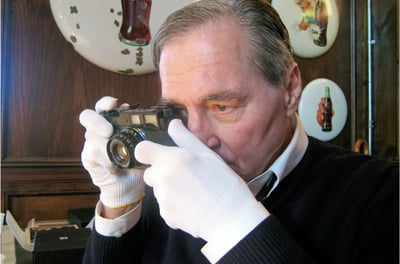Inspiration Through the Lens: The Impact of William Eggleston on Film Photography
3/4/20255 min read


The Journey Begins: William Eggleston's Early Days
William Eggleston’s journey into the world of photography began in earnest in 1957 when he received his first camera, a gift that would ultimately reshape his future. This pivotal moment marked the start of a lifelong fascination with capturing the essence of everyday life through the lens. At the time, Eggleston was a young boy, influenced by his surroundings, which included the vibrant Southern landscapes and the cultural nuances of his upbringing in Mississippi.
Initially, Eggleston's photographic pursuits were focused on black-and-white images, a choice that allowed him to develop a keen sense of composition and contrast. The monochrome palette enabled him to hone his technical skills and understand the foundational elements of photography, including lighting and framing. This early engagement with black-and-white photography proved crucial, as it laid the groundwork for his later transition to color, a medium that Eggleston would ultimately revolutionize within the field of film photography.
During these formative years, Eggleston’s work was heavily influenced by his experiences and environments, encouraging him to explore the mundane aspects of life that often go unnoticed. His images started to reflect a personal narrative, capturing scenes that were both ordinary and profound. This exploration of the commonplace would become a hallmark of his photographic style, as he developed a unique ability to transform the banal into something strikingly beautiful.
Eggleston’s early experimentation was not merely a hobby but a vital step in his artistic development. The practice of engaging with his surroundings through his camera allowed him to cultivate a distinctive vision that would later emerge in his iconic works. It was during this period that Eggleston began to establish his identity as a photographer, sowing the seeds for what would eventually become a significant impact on the realm of color film photography.
The Technicolor Revolution: Embracing Color Photography
William Eggleston's transition to color photography in the mid-1960s represented a pivotal moment in the realm of visual arts. At a time when black-and-white photography dominated the field, Eggleston's bold embrace of color served as both a personal and artistic revolution. His pioneering efforts began with the use of dye-transfer printing, which facilitated vibrant color reproduction, enabling him to capture everyday scenes with unprecedented richness and depth.
Eggleston's work defied traditional conventions that relegated color photography to the realm of commercial work, instead positioning it as a serious art form. Through his lens, color became not merely an aesthetic choice but a critical component of storytelling. The interplay of hues in his photographs invited viewers to observe the mundane moments of life, reinterpreting them through a vivid palette that evoked emotion and introspection. His images often featured ordinary subjects, such as unremarkable objects or suburban landscapes, yet the way he employed color infused them with a unique vibrancy that resonated deeply with audiences.
This innovative approach was emblematic of the Technicolor revolution that Eggleston helped to usher in. By challenging the established norms of visual representation, he paved the way for future generations of photographers to explore color with the intentionality and creativity previously reserved for their black-and-white predecessors. As critics began to recognize the artistic potential of color photography through Eggleston's lens, it marked a decisive shift in how the medium was regarded. The vibrancy of his color work became a staple of contemporary photography, reinforcing the notion that color can profoundly influence an image's emotional impact and narrative strength.
A Personal Favorite: 'The Seductive Allure of the Diner'
William Eggleston's seminal photograph, 'The Seductive Allure of the Diner,' stands as a significant piece within the realm of film photography, evoking a multitude of emotions and reflections. This iconic image captures the essence of America through a seemingly simple scene, yet it transcends the mundane to unveil layers of meaning and storytelling. At the core of this photograph is a vibrant interplay of color and composition, which highlights Eggleston's mastery in using the medium to express his perceptions of everyday life.
The diner setting serves as a microcosm of culture and human interaction. With its stark fluorescence and contrasting shadows, Eggleston engages viewers in a moment that is both intimate and universal. The colors pulsate, drawing the eye to various elements within the frame—the blues and reds resonate with nostalgia, while the shadows create depth, inviting the viewer to linger longer than they might in real life. This duality captivates me; it tells a story of both isolation and connection, embodying the complexities of modern existence.
Moreover, the visual storytelling techniques employed in this piece are noteworthy. Eggleston's ability to extract beauty from the ordinary challenges the viewer's perception, encouraging a contemplative engagement with the photograph. The diner, often seen as a transient space, transforms into a lasting symbol of place and memory. It provokes introspection about one's experiences within such environments, making it deeply personal while remaining universally relatable.
Personally, 'The Seductive Allure of the Diner' resonates with my own journey into film photography. It has inspired me to explore the narratives held within the frames of my work, to seek beauty in the mundane, just as Eggleston has brilliantly conveyed. This photograph, straightforward yet profoundly complex, underscores the infinite storytelling potential found within the confines of a single moment captured on film.
Legacy and Influence: Eggleston's Role in Modern Photography
William Eggleston is widely regarded as the 'father of modern color photography,' a title that reflects his pioneering approach to the medium during a time when color was often deemed inappropriate for serious art photography. His work is characterized by an acute attention to everyday life, capturing mundane scenes and objects with an extraordinary eye for detail and an appreciation for vibrant colors. Eggleston drew inspiration from renowned photographers such as Robert Frank and Henri Cartier-Bresson, whose emphasis on candid moments and documentary-style photography undoubtedly influenced his artistic vision. Eggleston transformed how color is perceived in photography, challenging conventions and opening new possibilities for expression.
The impact of Eggleston’s work can be seen in the evolution of photography as a whole, particularly in how photographers approach the use of color. His unique ability to portray the ordinary in extraordinary ways has inspired countless photographers seeking to convey deeper narratives through vivid imagery. The influence of his seminal work, such as “William Eggleston’s Guide,” extends beyond traditional confines, as many contemporary photographers have adopted a similar style, focusing on the beauty of the commonplace. In turn, this shift has led to an expanded appreciation of color photography, positioning it as a legitimate art form on par with black and white photography.
Personally, Eggleston's legacy has shaped my own journey into photography. His fearless exploration of colors and textures has encouraged me to seek out beauty in the everyday, pushing me to capture moments that may otherwise go unnoticed. Moreover, his work has instilled a sense of curiosity about the world, inviting photographers to craft their narrative through their lens, thus continuing to inspire future generations. As such, William Eggleston's contributions have undeniably left an indelible mark on modern photography, reinforcing the importance of personal vision and the celebration of the ordinary.
The Seductive Allure of the Diner


